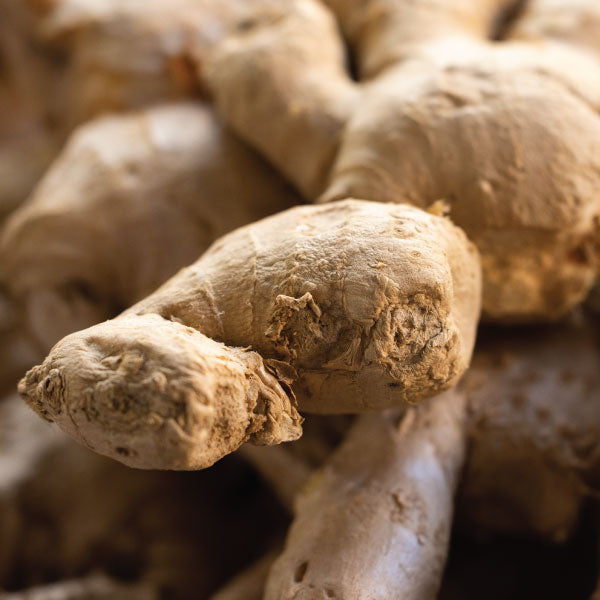
The Secret To More Energy With Less Caffeine: Alpinia Galanga
Alpinia galanga1, a rhizome in the ginger family used largely as an herb in Unani medicine and as a spice in Arab and Southeast Asian cuisine. It is one of four plants known as "galangal".
Discovery
In 2013 Enovate Biolife embarked on a research project looking into the energy promoting and cognitive enhancing benefits of 36 different botanicals. They discovered pyrocatecollic tannins and polyphenols in Alpinia galanga (galangal) that outperformed all other plants1.
These compounds helped provided alertness, focus, and mood-boosting benefits that could not be ignored.
The next step was to support the local farmers to grow and harvest this DNA authenticated galangal sustainably in the mountainous regions of India. This needed to be achieved without the use of chemicals, pesticides, or GMOs.
After rigorous clinical trials and working tirelessly to support the farming infrastructure, they were ready to start harvesting and processing Alpinia galanga.
The concentrated extract was made commercially available in 2018.
One short year later this ingredient was winning gold medals for innovation at the 2019 prestigious Nutra Ingredients Awards.
Human research to date has focused on safety and mental cognition. Studies have shown Alpinia galanga at doses of 150 - 300mg are both safe and effective.
In one study Alpinia galanga amplified caffeine by 30% and sharpened focus, alertness, and energy for up to 5 hours without a crash2.
In another study of 70 healthy caffeine habituated (400 mg/day) individuals, Alpinia galanga was shown to increase alertness by 107% within 1 hour compared to baseline3.
- Supports Attention – Focus on the details3.
- Supports Memory – Recall more information4,5.
- Neuroprotective Benefits – Reduce mental decline4,5,6.
- Preserves Acetylcholine – Support working memory and muscle movement4,5.
- Upregulates Super Oxide Dismutase & Glutathione – Supports endogenous antioxidant systems4,5,6,8.
- Downregulates Monoamine Oxidase – Helps preserve mood-boosting neurotransmitters in the brain5.
- Downregulates Lipid Peroxidase – Reduces oxidative stress & slows aging of cells6,8.
- Supports Central Nervous System Activity – Boost energy and reduce fatigue7.
- Supports Locomotor Activity – Enhance hand-eye co-ordination7.
- Enhances Adrenaline and Dopamine Receptors – Boost Energy, Mood, Focus and Motivation7.
- Supports Cardiovascular Health – Helps with cardiac output8,9.
Other Potential Benefits:
Alpinia Galanga is part of the Zingiberaceae family which includes ginger and turmeric. All these rhizomes have a long history of culinary use in Asia and India. They’re also widely used for many different ailments in Ayurvedic and Traditional Chinese Medicine (TCM)9.
We know they have powerful anti-inflammatory, anti-bacterial and adaptogenic properties. This puts galangal (Alpinia Galanga) at the top of the list for wholistic health. It’s the adaptogenic benefits that hold the secret to brain-boosting focus.
Adaptogens are known to help improve adrenal receptor sensitivity which can become resistant the more often we are stressed or consume caffeine10. Adaptogens allow our body to adapt and perform better in this environment.
To find a botanical that may provide so many health benefits while enhancing caffeine, supporting cognition, focus and alertness is extremely exciting.
In fact, being able to provide more energy with less caffeine will be highly desirable to many consumers who either find caffeine does nothing (caffeine resistant) or makes them jittery and crash.
Alpinia galanga with and without caffeine will help boost your brain power, enhance your alertness and productivity in or out of the gym.
Coffee Switch has been created for this exact purpose; to help refocus naturally. Plus, it’s simply just delicious and convenient.
Dosage:
150 – 300mg per serve 1-3 x daily.
REFERENCES
[1] D. Kaushik, J. Yadav, P. Kaushik, D. Sacher, R. Rani, Zhong Xi Yi Jie He Xue Bao 9 (2011) 1061–1065.
[2] S. Srivastava, M. Mennemeier, S. Pimple, J. Am. Coll. Nutr. 36 (2017) 631–639.
[3] S. Shalini Srivastava, BAOJN 3 (2017) 1–10.
[4] J.C. Hanish Singh, V. Alagarsamy, P.V. Diwan, S. Sathesh Kumar, J.C. Nisha, Y. Narsimha Reddy, J. Ethnopharmacol. 138 (2011) 85–91.
[5] J.C. Hanish Singh, V. Alagarsamy, S. Sathesh Kumar, Y. Narsimha Reddy, Phytother. Res. 25 (2011) 1061–1067.
[6] R. Mundugaru, S. Sivanesan, P. Udaykumar, V. Dj, S.N. Prabhu, B. Ravishankar, IJPER 52 (2018) s77–s85.
[7] S. Saha, S. Banerjee, Indian J. Exp. Biol. 51 (2013) 828–832.
[8] P. Kaushik, D. Kaushik, J. Yadav, P. Pahwa, Pak. J. Biol. Sci. 16 (2013) 804–811.
[9] R.K. Verma, G. Mishra, P. Singh, K.K. Jha, R.L. Khosa, Ayu 36 (2015) 91–95.
[10] D. Bendjeddou, K. Lalaoui, D. Satta, J. Ethnopharmacol. 88 (2003) 155–160.

